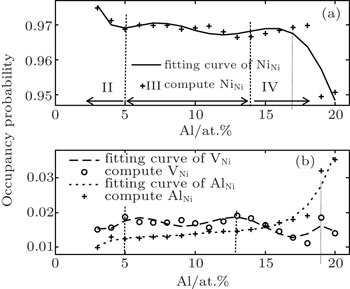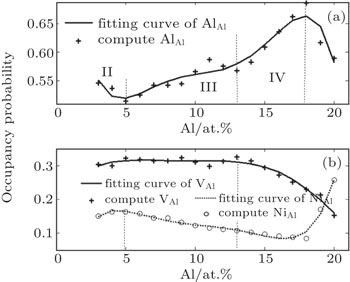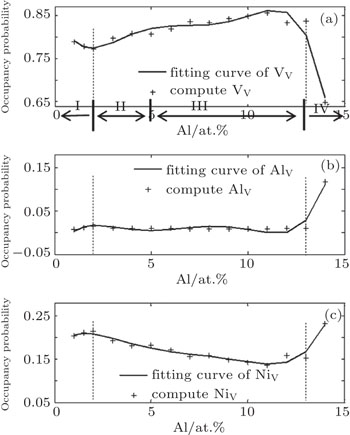† Corresponding author. E-mail:
Project supported by the Natural Science Basic Research Plan in Shaanxi Province of China (Grant No. 2016JQ5014), the Fundamental Research Funds for the Central Universities, China (Grant No. 3102014JCQ01024), the Research Fund of the State Key Laboratory of Solidification Processing (NWPU), China (Grant No. 114-QP-2014), the Specialized Research Fund for the Doctoral Program of Higher Education of China (Grant No. 20136102120021), and the National Natural Science Foundation of China (Grant Nos. 51474716 and 51475378).
Anti-structured defects bridge atom migration among heterogeneous sublattices facilitating diffusion but could also result in the collapse of ordered structure. Component distribution Ni75AlxV25−x alloys are investigated using a microscopic phase field model to illuminate relations between anti-structured defects and composition, precipitate order, precipitate type, and phase stability. The Ni75AlxV25−x alloys undergo single Ni3V (stage I), dual Ni3Al and Ni3V (stage II with Ni3V prior; and stage III with Ni3Al prior), and single Ni3Al (stage IV) with enhanced aluminum level. For Ni3V phase, anti-structured defects (VNi1, NiV, except VNi2) and substitution defects (AlNi1, AlNi2, AlV) exhibit a positive correlation to aluminum in stage I, the positive trend becomes to negative correlation or smooth during stage II. For Ni3Al phase, anti-structured defects (AlNi, NiAl) and substitution defects (VNi, VAl) have a positive correlation to aluminum in stage II, but NiAl goes down since stage III and lasts to stage IV. VNi and VAl fluctuate when Ni3Al precipitates prior, but go down drastically in stage IV. Precipitate type conversion of single Ni3V/dual (Ni3V+Ni3Al) affects Ni3V defects, while dual (Ni3V+Ni3Al)/single Ni3Al has little effect on Ni3Al defects. Precipitate order swap occurred in the dual phase region affects on Ni3Al defects but not on Ni3V.
Defects of intermetallic compounds have been widely studied, and will stay active as long as structural materials are in service.[1–5] These defects include dislocations, vacancies, and substitution defects. Dislocations explain that the deformation strengthening vacancies are necessary for atom diffusion, while substitution defects account for solid solution strengthening. However, another kind of defects, named anti-structured defects, have been discussed frequently in semiconductors but scarcely mentioned in structural materials.[6–8] Anti-structured defects are intrinsic defects that strongly rely on temperature and composition. It is not generally distinguished from substitution defects in intermetallic structural materials. An anti-structured atom is usually defined as mistaken atom occupancy. Take face centered cubic A3B type intermetallic compounds as an example, an A atom resides on the face center (α sublattice) while B is on the corner (β sublattice) in a perfect cube, when A replaces B on the corner an anti-structured defect AB arises. Similarly, BA indicates that an anti-structured atom B replaces the host atom A on α sublattice (face center), graphically demonstrated in Fig.
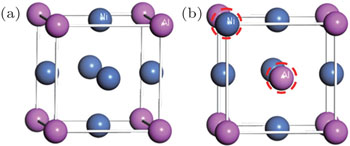 | Fig. 1. Schematic representation of L12-Ni3Al: (a) perfect structure, (b) an example of anti-structured defects NiAl and AlNi (gray dots are Ni atoms, purple dots are Al atoms). |
Diffusion by vacancy migration is generally accepted in the tradition. Theoretical computation verified the overwhelming superiority of anti-structured defects in intermetallic compounds, therefore, the idea that atom diffuses via anti-structured defects arises.[13,17,20] Take the L12-Ni3Al phase as an example, one nickel atom is accompanied by eight nickel atoms and four aluminum atoms, therefore, a nickel atom can migrate by exchanging with the neighbor nickel (α sublattice) without disturbing the β sublattice. An aluminum atom has twelve direct bonded nickel atoms as neighbors, thus, it is unfavorable for it moving exclusively through the β sublattice, it has to migrate through the α sublattice via anti-structured defects AlNi. As a matter of fact, even a nickel atom also migrates through α and β sublattices with the participation of anti-structured defects NiAl.[25,26]
Ternary Ni–Al–V alloy, having fcc-derived L12-Ni3Al and D022-Ni3V phases precipitate competitively, exhibits prominent performance such as outstanding high-temperature strength, high structure stability, and good oxidation resistance ascribing to the abnormal stress effect. Ni3Al phase can hold L12 configuration until the melting point because of the low diffusivity due to the geometry close packing structure. Ni3V phase with D022 configuration is unstable when aluminum is added, its β sublattice is prone to be occupied by aluminum addition, and leads to the Ni3(Al, V) phase transforms from D022 to L12. Ni3(Al, V) compound may display L12 structure or D022 structure while most experimental observation and theoretical computation favor L12 other than D022.[1,2] This intrinsic property of D022 structure can also account for drastic Ni3V reduction when the aluminum composition is slightly enhanced. Both Ni3Al and Ni3V phases are characterized by low vacancies but concentrated anti-structured defects.[26,27] Many prominent properties are related to the thermodynamic equilibrium anti-structured defects linking to chemical composition. The relation between anti-structured defects and the composition is clarified by the manipulating chemical ratio of Al/V in Ni75AlxV25−x alloys in this study. For such an L12–D022 competitive precipitation system the relation is more than a simple issue related to the composition but to the precipitate type and the order with the composition varying.
The microscopic phase field model is generally used to describe the microstructure evolution and the related quantitative prediction.[28–31] It characterizes the phase transition and the morphology evolution using single sublattice atom occupancy probabilities PA(r, t), PB(r, t), and PC(r, t), for a ternary system. Here, PA(r, t), PB(r, t), and PC(r, t) represent the single sublattice atom occupancy probabilities of elements A, B, and C at a given time t and sublattice r, respectively. Ignore the vacancy effect and simplify the model, these three atom occupancy probabilities fulfil PA(r, t) + PB(r, t) + PC(r, t) = 1 with only two independent items on each sublattice. Suppose A and B are the two independent variables, the Langevin-type dynamic equation is given by[32]

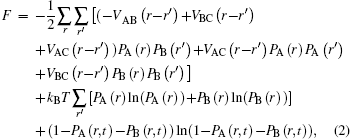




Nickel and aluminum interaction: V1 = 122.30, V2 = 6.0, V3 = 16.58, and V4 = −6.82;
Nickel and vanadium interaction: V1 = 107.2, V2 = 32.0, V3 = −9.6, and V4 = 12.8;
Aluminum and vanadium interaction: V1 = 40.0, V2 = −30.0, V3 = −80.0, and V4 = 0.0. The interaction energy can be written as
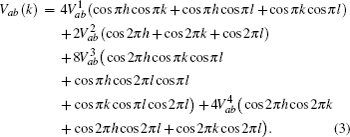
Computation proceeds on a 128 × 128 matrix with periodic boundary condition applied along both Cartesian axes. The Ni75AlxV25−x alloys contain 75 at.% nickel and total 25 at.% aluminum and vanadium. Aluminum composition is enhanced consecutively from 1 at.% Al to 20 at.% Al with a concentration gradient of 1%. Atom occupancy probabilities of nickel, aluminum and vanadium are checked on each 128 × 128 site for these alloys.
Precipitated phases Ni3V and Ni3Al evolve in a way “single Ni3V phase → dual Ni3Al and prior Ni3V phase → dual Ni3V and prior Ni3Al phase → single Ni3Al phase” with the enhanced aluminum composition, a typical example of such a “microstructure-chemical composition relation” is shown in Fig.
Stage I: at.% Al< 2 at.%, single Ni3V phase region;
Stage II: 2 at.% < at.% Al< 5 at.%, dual Ni3Al and prior Ni3V phase region with Ni3V precipitates prior to Ni3Al;
Stage III: 5 at.% < at.% Al< 13 at.%, dual Ni3V and prior Ni3Al phase region with Ni3Al precipitates prior to Ni3V;
Stage IV: at.% Altextgreater 13 at.%, single Ni3Al phase region.
The four stages are graphically demonstrated in Fig.
Figure
Atom occupancy–composition relation on β sublattice is demonstrated in Fig.
As stated above, anti-structured defects as well as other atoms show a certain composition correlation depending on the precipitate order and precipitated phases. First, the α sublattice is predominated by the host nickel with little anti-structured defects AlNi and substitution defects VNi. AlNi has a constant positive correlation with an enhanced aluminum level, precipitate order swap does not affect its occupancy while precipitated phase conversion of “dual Ni3V and Ni3Al/single Ni3Al” does as the rising trend lasts to a single Ni3Al region. The atom occupancy of substitution defects VNi fluctuates in a small range, and their composition correlation varies when the precipitate order swaps at 5 at.%Al or Ni3V phases disappear at 13 at.% Al. Second, compared with the α sublattice, the β sublattice accommodates more alien atoms, the atom occupancy of anti-structured defects NiAl is almost ten times higher than that of AlNi. NiAl and host AlAl present just opposite composition correlations, and strongly depend on the precipitate order and precipitated phases. Substitution defects VAl take almost one third of that of the β sublattice, they are not affected by the precipitate order but by the disappearance of Ni3V.
It is easy to understand the positive composition correlation of anti-structured defects AlNi and host AlAl in stages III and IV, as concentrated aluminum-concentration concentrated aluminum-occupancy. The enhanced aluminum composition means lessened vanadium, however, the vanadium occupancy is comparatively smooth and does not lessen seriously over stages II, III and IV. Once Ni3Al phases start to precipitate, their volume fraction increases fast, thus, the average nickel and aluminum atom assigned to each L12 cube lessens, that is, the atom occupancies of host NiNi and AlAl decrease, consequently, the spared sublattice replaced by anti-structured or substitution defects is enhanced in stage II. Ni3Al precipitates prior to Ni3V since stage III, their volume fraction keeps increasing and holds a high NiNi occupancy, which demands vast nickel, thus, nickel atoms that serve as anti-structured defects NiAl reduce. Ni3V phases fade since stage IV, Ni3Al phases coalesce to a larger size, the atom composition correlation is simply ascribed to the Ni3Al volume and the aluminum composition. Ni3V volume fraction decreases fast in the whole process, which releases a large amount of vanadium. The released vanadium weighs more than the lessened one, thus, the surplus one is accommodated by Ni3Al and comes to a rough balance, that is why the vanadium occupancy fluctuates with the sharply increased Ni3Al over stages II, III, and IV.
The Ni3Vα sublattice is subdivided into two other sublattices, a Ni1 sublattice, and a Ni2 sublattice according to their coordination sphere differences. Figure
 | Fig. 6. Atom occupancy–composition relation of Ni3V α sublattice. (a) NiNi1 and NiNi2, (b) AlNi1 and AlNi2, and (c) VNi1 and VNi2. |
Atom occupancy–composition relation on the β sublattice is presented in Fig.
There is an occupancy difference in the two nickel sublattices, that is, the Ni1 sublattice accommodates a few anti-structured defects VNi1 and more substitution defects AlNi1 while the Ni2 sublattice accommodates more anti-structured defects VNi2 and a few substitution defects AlNi2. This occupancy difference is ascribed to their coordination sphere difference but the exact mechanism is unknown. Compared with the α sublattice, the β sublattice is easier to be replaced by alien atoms anti-structured defects NiV dominate on the β sublattice with very little substitution defects AlV.
The precipitate order swap at 5 at.%Al has no obvious effect on the atom occupancy, while precipitate phase conversion of “single Ni3V/dual Ni3Al and Ni3V” since 2 at.%Al does. It is easy to understand that the atom occupancies of substitution defects AlNi1, AlNi2, and AlV increase and that of anti-structured defects VNi2 decreases in stage I as aluminum is enhanced while vanadium is lessened. Anti-structured defects VNi1 and VNi2 have a positive composition correlation, anti-structured defects NiV have negative one while aluminum occupancy fluctuates in a small range over stages II and III. As discussed in the last section, the Ni3V volume fraction goes down fast and releases a large amount of vanadium which is used to compensate the Ni3Vβ sublattice, dissolve into the Ni3V α sublattice, and be accommodated by the Ni3Al β sublattice, that is why the atom occupancies of VNi1, VNi2, and VV increase. On the Ni3Vβ sublattice, the increase of vanadium (VV) cause nickle occupancy (NiV) down. Similar to the role of vanadium on Ni3Al, the atom occupancies of substitution defects AlNi1, AlNi2, and AlV on Ni3V fluctuate due to the rough balance.
Microscopic phase field computation is proceeded on a 128 × 128 matrix to investigate anti-structured defects. A series of Ni–Al–V samples with aluminum composition ranging from 1 at.% Al to 20 at.% Al are examined. Four stages are summarized according to the precipitate order and precipitated phases. Precipitated phases converse at separate 2 at.% Al and 13 at.% Al with dual Ni3Al and Ni3V in the middle, single Ni3V on the heading, and single Ni3Al on the tail. The precipitate order swaps at 5 at.% Al, which Ni3V precipitates prior with insufficient aluminum composition and Ni3Al precipitates prior since 5 at.% Al.
Anti-structured defects NiAl dominate in Ni3Al phases while AlNi are minor. The Ni3Al β sublattice accommodates a large amount of anti-structured defects NiAl and substitution defects VAl. All defects show positive composition correlations in stage II. The atom occupancy of AlNi goes up slightly while that of NiAl decreases since 5 at.%Al, this trend lasts to the single Ni3Al region. The atom occupancies of substitution defects VNi and VAl fluctuate in a small range over stage III, and decrease drastically from a single Ni3Al region.
The Ni3V β sublattice is easier to be replaced by defects than their α sublattice. Both anti-structured defects and substitution defects have a positive composition correlation except VNi2 in the single Ni3V region; this positive trend inverses or becomes smooth since the Ni3Al phases start to precipitate at 2 at.%Al. The atom occupancy of anti-structured defects NiV keeps decreasing while that of substitution defects VNi2 keeps increasing over the whole dual phases region, the precipitate order swap at 5 at.%Al does not have much effect on the atomic occupancy.
In a word, the precipitate order swap effects Ni3Al defects while the precipitated phase conversion effects Ni3V defects. No matter what Ni3Al phases or Ni3V phases are, their β sublattices are easier to be replaced by anti-structured defects or substitution defects.
| 1 | |
| 2 | |
| 3 | |
| 4 | |
| 5 | |
| 6 | |
| 7 | |
| 8 | |
| 9 | |
| 10 | |
| 11 | |
| 12 | |
| 13 | |
| 14 | |
| 15 | |
| 16 | |
| 17 | |
| 18 | |
| 19 | |
| 20 | |
| 21 | |
| 22 | |
| 23 | |
| 24 | |
| 25 | |
| 26 | |
| 27 | |
| 28 | |
| 29 | |
| 30 | |
| 31 | |
| 32 |





